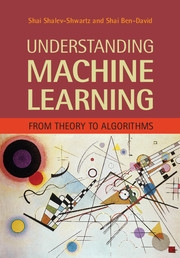Book contents
- Frontmatter
- Dedication
- Contents
- Preface
- 1 Introduction
- Part 1 Foundations
- Part 2 From Theory to Algorithms
- 9 Linear Predictors
- 10 Boosting
- 11 Model Selection and Validation
- 12 Convex Learning Problems
- 13 Regularization and Stability
- 14 Stochastic Gradient Descent
- 15 Support Vector Machines
- 16 Kernel Methods
- 17 Multiclass, Ranking, and Complex Prediction Problems
- 18 Decision Trees
- 19 Nearest Neighbor
- 20 Neural Networks
- Part 3 Additional Learning Models
- Part 4 Advanced Theory
- Appendix A Technical Lemmas
- Appendix B Measure Concentration
- Appendix C Linear Algebra
- References
- Index
20 - Neural Networks
from Part 2 - From Theory to Algorithms
Published online by Cambridge University Press: 05 July 2014
- Frontmatter
- Dedication
- Contents
- Preface
- 1 Introduction
- Part 1 Foundations
- Part 2 From Theory to Algorithms
- 9 Linear Predictors
- 10 Boosting
- 11 Model Selection and Validation
- 12 Convex Learning Problems
- 13 Regularization and Stability
- 14 Stochastic Gradient Descent
- 15 Support Vector Machines
- 16 Kernel Methods
- 17 Multiclass, Ranking, and Complex Prediction Problems
- 18 Decision Trees
- 19 Nearest Neighbor
- 20 Neural Networks
- Part 3 Additional Learning Models
- Part 4 Advanced Theory
- Appendix A Technical Lemmas
- Appendix B Measure Concentration
- Appendix C Linear Algebra
- References
- Index
Summary
An artificial neural network is a model of computation inspired by the structure of neural networks in the brain. In simplified models of the brain, it consists of a large number of basic computing devices (neurons) that are connected to each other in a complex communication network, through which the brain is able to carry out highly complex computations. Artificial neural networks are formal computation constructs that are modeled after this computation paradigm.
Learning with neural networks was proposed in the mid-20th century. It yields an effective learning paradigm and has recently been shown to achieve cutting-edge performance on several learning tasks.
A neural network can be described as a directed graph whose nodes correspond to neurons and edges correspond to links between them. Each neuron receives as input a weighted sum of the outputs of the neurons connected to its incoming edges. We focus on feedforward networks in which the underlying graph does not contain cycles.
In the context of learning, we can define a hypothesis class consisting of neural network predictors, where all the hypotheses share the underlying graph structure of the network and differ in the weights over edges. As we will show in Section 20.3, every predictor over n variables that can be implemented in time T(n) can also be expressed as a neural network predictor of size O(T(n)2), where the size of the network is the number of nodes in it.
Information
- Type
- Chapter
- Information
- Understanding Machine LearningFrom Theory to Algorithms, pp. 228 - 242Publisher: Cambridge University PressPrint publication year: 2014
Accessibility standard: Unknown
Why this information is here
This section outlines the accessibility features of this content - including support for screen readers, full keyboard navigation and high-contrast display options. This may not be relevant for you.Accessibility Information
- 1
- Cited by
